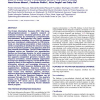Free Online Productivity Tools
i2Speak
i2Symbol
i2OCR
iTex2Img
iWeb2Print
iWeb2Shot
i2Type
iPdf2Split
iPdf2Merge
i2Bopomofo
i2Arabic
i2Style
i2Image
i2PDF
iLatex2Rtf
Sci2ools
NAR
1998
1998
The PIR-International Protein Sequence Database
The Protein Information Resource (PIR; http://wwwnbrf.georgetown.edu/pir/ ) supports research on molecular evolution, functional genomics, and computational biology by maintaining a comprehensive, non-redundant, well-organized and freely available protein sequence database. Since 1988 the database has been maintained collaboratively by PIR-International, an international association of data collection centers cooperating to develop this resource during a period of explosive growth in new sequence data and new computer technologies. The PIR Protein Sequence Database entries are classified into superfamilies, families and homology domains, for which sequence alignments are available. Full-scale family classification supports comparative genomics research, aids sequence annotation, assists database organization and improves database integrity. The PIR WWW server supports direct on-line sequence similarity searches, information retrieval, and knowledge discovery by providing the Protein S...
| Added | 22 Dec 2010 |
| Updated | 22 Dec 2010 |
| Type | Journal |
| Year | 1998 |
| Where | NAR |
| Authors | Winona C. Barker, John S. Garavelli, Daniel H. Haft, Lois T. Hunt, Christopher R. Marzec, Bruce C. Orcutt, Geetha Y. Srinivasarao, Lai-Su L. Yeh, Robert S. Ledley, Hans-Werner Mewes, Friedhelm Pfeiffer, Akira Tsugita |
Comments (0)

